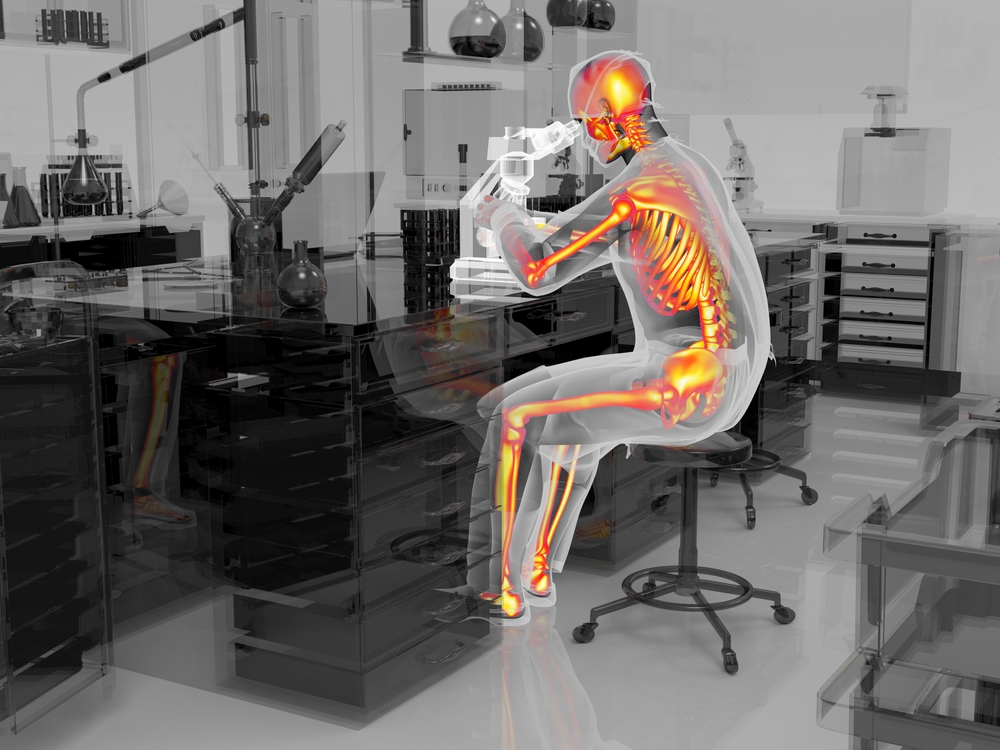
In the dynamic environment of modern laboratories, the design of lab tables and workbenches plays a pivotal role in both the well-being of lab workers and the efficiency of their work. Ergonomics, the science of designing workplaces to fit the needs and capabilities of workers, is crucial in creating workspaces that minimize physical strain and maximize productivity.
This article explores the importance of ergonomic considerations in the design of lab tables and workbenches, highlighting how these elements contribute to a safer, more comfortable, and more efficient laboratory setting. By examining key ergonomic principles and their practical applications, we aim to illustrate the significant benefits that thoughtful design can bring to laboratory environments.
Ergonomics as it Relates to Laboratory Environments?
Ergonomic design refers to creating products and environments that fit the physical needs and capabilities of the user, ensuring comfort, efficiency, and safety. The term “ergonomic” is derived from the Greek words “ergon,” meaning work, and “nomos,” meaning natural laws or management.
This concept emphasizes the importance of designing laboratory tables and workbenches that support the natural movements and postures of lab workers, reducing the risk of strain and injury, and enhancing overall productivity. Ergonomics takes into account factors such as adjustability, proper height, and accessibility to equipment, aiming to create a workspace that promotes well-being and optimal performance.
Anthropometric measurements and percentile humans play a crucial role in the ergonomic design of lab tables and workbenches.
- Anthropometric measurements refer to the dimensions and physical characteristics of the human body, such as height, arm length, and reach. Designers use these measurements to create workspaces that accommodate a diverse range of body sizes and shapes.
- Percentile humans are statistical representations of human body dimensions, typically expressed in terms of percentiles (e.g., 5th, 50th, 95th percentile). In ergonomic design, this concept ensures that the majority of the population can comfortably and safely use the lab tables and workbenches.
For example, a workbench height might be adjustable to cater to the 5th percentile (smaller individuals) to the 95th percentile (larger individuals), ensuring that it is suitable for almost everyone.
By incorporating anthropometric data and considering percentile ranges, designers can create lab tables and workbenches that minimizes strain, enhances comfort, and boosts productivity for all users.

What are the Ergonomic Risk Factors for Lab Workers?
Ergonomic risk factors for laboratory workers, spending many hours working at lab tables and workbenches, include:
— Repetitive Motions: Performing the same tasks repeatedly, such as pipetting or typing, can lead to repetitive strain injuries (RSIs).
— Awkward Postures: Sustaining unnatural positions, like leaning over microscopes or reaching across benches, can cause musculoskeletal disorders (MSDs).
— Forceful Exertions: Applying excessive force during tasks, such as tightening or loosening equipment on lab tables and workbenches, can strain muscles and joints.
— Contact Stress: Prolonged pressure from hard surfaces or sharp edges on the body, particularly the hands, wrists, and forearms, can cause discomfort and injury.
— Static Postures: Maintaining a single position for extended periods, like standing or sitting without movement, can lead to fatigue and circulatory issues.
— Poorly Designed Workstations: Workspaces that are not adjustable or tailored to the worker’s body can cause strain, discomfort, and inefficiency.
— Improper Equipment Placement: Tools and materials on lab tables and workstations that are not within easy reach or require awkward movements to access can contribute to ergonomic stress.
Addressing these risk factors through proper ergonomic design and practices of lab tables and workbenches can help prevent injuries and promote a healthier, more productive work environment.

Ergonomic Design for Common Postures
Common postures of researchers and lab workers include standing, sitting, reaching, and moving. Ergonomics in the design of lab tables and workbenches play a crucial role in optimizing each of these postures to prevent strain and enhance productivity:
1. Standing:
— Posture: Researchers often stand while conducting experiments or using equipment.
— Ergonomic Considerations: Adjustable-height tables and anti-fatigue mats can help reduce strain on the legs and lower back. Ensuring that work surfaces are at the appropriate height can prevent hunching or overreaching.
2. Sitting:
— Posture: Sitting is common during tasks like microscope work or data entry.
— Ergonomic Considerations: Ergonomically designed chairs with proper lumbar support and adjustable features can prevent back and neck strain. Work surfaces should be at a height that allows the elbows to be at a 90-degree angle to avoid shoulder and arm fatigue.
3. Reaching:
— Posture: Reaching for tools, materials, or equipment stored on shelves or across the workbench.
— Ergonomic Considerations: Frequently used items should be within easy reach to minimize excessive stretching. Lab tables and workbenches with adjustable shelving and properly organized workspaces can reduce the need for awkward reaching, which can cause shoulder and back strain.

4. Moving:
— Posture: Walking, bending, and twisting to access different parts of the lab or to perform various tasks.
— Ergonomic Considerations: Clear pathways and strategically placed equipment can reduce unnecessary movements. Ergonomically designed laboratory workbenches and tables that allow easy access to all necessary tools and materials can minimize the need for repetitive bending or twisting. Lab tables and workbenches on casters can boost efficiency.
Incorporating ergonomic principles into the design of lab tables and workbenches helps create a safer and more comfortable working environment, reducing the risk of injury and increasing efficiency for lab workers.
Related Reading: Choosing the Right Lab Benches for Your Research Needs

Height Adjustability for Lab Tables and Workbenches
Adjustable workbenches and lab tables are essential for supporting lab operators’ tasks effectively, whether sitting or standing, and should allow at least three heights. Proper placement of items on the work surface is crucial to prevent movements that require prolonged muscle contraction.
- The optimal height for standing workstations varies depending on the task at hand. For heavy-duty tasks, the table should be at a height that provides good leverage for lifting and moving objects.
- Conversely, for precision tasks on lab equipment, the desk height should be slightly higher to facilitate small, detailed movements and allow the worker to closely focus on their work.

- For data entry and other tasks performed while seated, the work surface should be lowered to align properly with an ergonomically designed chair or an adjustable-height stool. Other ergonomic aids such as keyboard trays, monitor arms, and footrests can enhance a healthy workspace. This setup ensures that the worker can maintain a comfortable and efficient posture.
To prevent blood from pooling in the legs while standing, it’s important to encourage movement. Using anti-fatigue mats can also help by distributing body weight more evenly and reducing strain on the feet. Additionally, ergonomic lab benches may have features such as footrests, tilt options, and ergonomic seating to promote good posture and reduce fatigue.

Universal Design — Essential for Ergonomics and Efficiency
Designing lab workbenches and tables to accommodate everyone is crucial for creating an inclusive and efficient workspace. Compliance with the Americans with Disabilities Act (ADA) regulations ensures that lab environments are accessible to individuals with disabilities, providing equal opportunities for all workers.
However, ergonomic design should go beyond just meeting ADA requirements; it should also consider the specific needs of those with temporary physical limitations, such as sprained wrists, fractured bones, or pregnancy. Some lab workers may need assistive walking devices such as canes, crutches, or walkers.
Ergonomic considerations are vital for addressing the diverse needs of the workforce. Adjustable-height lab tables and workbenches can help accommodate varying body sizes and postures, ensuring that each worker can maintain a comfortable and safe position.
For those with temporary limitations, features like easy-to-reach controls, supportive seating, and adjustable work surfaces can make a significant difference in their ability to perform tasks without added strain or discomfort.
Additionally, many lab workers may live with daily physical limitations, such as those associated with aging. Ergonomic design that includes user-friendly interfaces, proper lighting, and equipment that minimizes repetitive strain can help mitigate the impact of these limitations.
Creating a lab space that supports the health and well-being of all employees enhances productivity and fosters an inclusive environment where every worker can thrive.
By prioritizing ergonomic design, labs can better accommodate the needs of all employees, ensuring a safe, comfortable, and accessible working environment.
Related Reading: Lab Counters: Selecting the Best Materials and Design for Your Workspace

Ergonomics Benefit Efficiency
Ergonomic lab tables and workbenches can significantly enhance efficiency in several ways:
- Improved Comfort and Reduced Fatigue: Ergonomic designs reduce physical strain and discomfort, allowing workers to maintain productivity for longer periods. Comfortable working conditions minimize fatigue, leading to sustained focus and efficiency.
- Enhanced Workflow: Properly designed workspaces streamline movements and reduce unnecessary reaching or stretching. This optimized workflow enables quicker and more efficient completion of tasks.
- Reduced Risk of Injury: Ergonomic lab workstations help prevent musculoskeletal disorders and repetitive strain injuries. Fewer injuries mean less downtime and absenteeism, maintaining consistent productivity levels.
- Increased Precision and Accuracy: Comfortable and well-supported workers can perform detailed tasks with greater precision and accuracy, reducing errors and improving the quality of work.
- Adaptability to Diverse Tasks: Adjustable tables and benches can be customized to suit different tasks and user preferences. This flexibility allows workers to switch between tasks seamlessly, maintaining efficiency across various activities.
- Better Use of Space: Ergonomic designs often include features that help organize tools and materials efficiently. An organized workspace with easily accessible storage options reduces the time spent searching for items and keeps the work area tidy, enhancing overall efficiency.
- Enhanced Employee Morale: Providing a comfortable and safe working environment boosts employee morale and job satisfaction. Happy and motivated workers are generally more productive and engaged in their tasks.
By incorporating ergonomic principles into lab tables and lab benches, laboratories can create a work environment that supports the physical well-being of employees, leading to increased efficiency, reduced errors, and improved overall productivity.
Physical Consequences of Non-Ergonomic Lab Tables and Workbenches

Working many hours at non-ergonomic lab tables and workbenches can lead to several physical consequences, including:
- Musculoskeletal Disorders (MSDs): Prolonged awkward postures and repetitive movements can cause strains and injuries to muscles, tendons, and nerves, leading to conditions such as carpal tunnel syndrome, tendonitis, and lower back pain.
- Neck and Shoulder Pain: Non-ergonomic setups often require workers to hunch over or reach awkwardly, leading to tension and pain in the neck and shoulders.
- Lower Back Pain: Inadequate support and improper workstation heights can cause workers to adopt poor postures, leading to chronic lower back pain.
- Leg and Foot Discomfort: Standing for long periods on hard surfaces without support can cause fatigue and discomfort in the legs and feet, potentially leading to varicose veins or other circulatory issues.
- Eye Strain and Headaches: Poor lighting and improper positioning of screens and work surfaces can cause eye strain, leading to headaches and reduced visual acuity over time.
- Decreased Circulation: Static postures and lack of movement can reduce blood flow, increasing the risk of circulatory problems and contributing to fatigue.
Addressing these issues through ergonomic design can help prevent these physical consequences and promote a healthier, more productive work environment.
Conclusion
While budget, cost-effectiveness, and durability play significant roles in laboratory design, the integration of ergonomic principles in the design of lab tables and workbenches is essential for fostering a productive, safe, and inclusive laboratory environment.
By addressing the diverse needs of lab workers, including those with temporary or permanent physical limitations, ergonomic designs enhance comfort, reduce the risk of injuries, and improve overall workflow efficiency.
Genie Scientific builds high-quality laboratory furniture for safety and compliance. Their specialty is lab design and custom tailoring solutions for specific lab tables and workbenches, fume hoods, casework, and other laboratory furniture to ensure their design aids efficiency, functionality, and lab staff wellness.
Compliance with ADA regulations ensures accessibility for all, while thoughtful design features further support the health and well-being of every worker.
Ultimately, investing in ergonomic lab tables and workbenches is not only a matter of regulatory compliance but also a strategic approach to optimizing lab operations and promoting a healthier, more engaged workforce.




